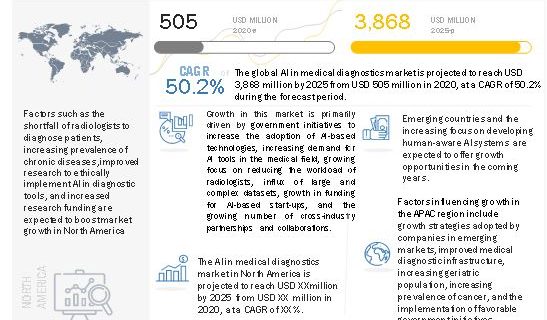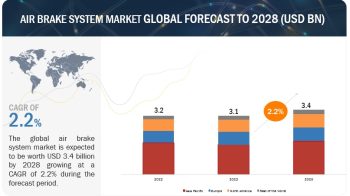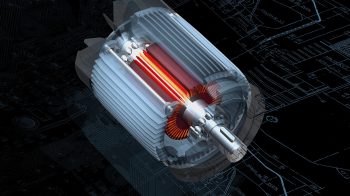
Pandemics such as COVID-19 require investments for additional manpower, equipment, consumables, and other resources to ensure 100% preparedness for safety in hospitals and, if needed, eventual treatment of patients. The COVID-19 pandemic is an accelerator for AI technology by creating opportunities for leveraging these tools for healthcare advancement.
AI and radiomics, which are being applied to X-ray and CT scans as advanced imaging tools in the detection and follow-up of COVID-19, have been able to diagnose the presence of the infection. This is because AI algorithms and radiomics used for chest X-rays can help undertake massive screening programs. For instance, Zhongnan Hospital (China) uses AI to interpret CT scans and identify COVID-19 symptoms when human radiologists are unavailable. Similarly, the Tampa General Hospital (Florida, US) uses an AI-driven technology to screen individuals for COVID-19 before they interact with the hospital staff and other patients. The Massachusetts General Hospital (Boston, US) also used AI-powered robots, which obtain vital signs and provide care to COVID-19 patients. This allows healthcare staff to potentially reduce human contact, which is important to curb the spread of the disease.
Download a PDF Brochure @ https://www.marketsandmarkets.com/pdfdownloadNew.asp?id=22519734
Providence St. Joseph Health (Seattle, US)
used an AI-powered chatbot that screened and triaged more than 40,000 patients,
categorizing them by the level of care needed and freeing doctors and nurses to
focus on at-risk individuals in an unprecedented time of one week. Thus,
physicians are taking the help of the augmented abilities of AI and responding
to the requirements efficiently and quickly.
Growth in Artificial Intelligence (Ai)
in Medical Diagnostics Market is primarily driven by government initiatives to
increase the adoption of AI-based technologies, increasing demand for AI tools
in the medical field, growing focus on reducing the workload of radiologists,
influx of large and complex datasets, growth in funding for AI-based start-ups,
and the growing number of cross-industry partnerships and collaborations.
[172 Pages Report] The global AI in medical diagnostics
market is projected
to reach USD 3,868 million by 2025 from USD 505 million in 2020, at a CAGR of
50.2% during the forecast period.
Software segment is expected to grow at the highest
CAGR
On the basis of component, the AI in medical diagnostics market is segmented into software and services. The services segment dominated this market in 2020, while the software segment is estimated to grow at a higher CAGR during the forecast period. Software solutions help healthcare providers gain a competitive edge despite the challenges of being short-staffed and facing increasing imaging scan volumes.
Request a Sample Pages @ https://www.marketsandmarkets.com/requestsampleNew.asp?id=22519734
Hospitals to establish the largest market size of AI in medical diagnostics market
Based on end user, the AI in medical diagnostics market is segmented into hospitals, diagnostic imaging centers, diagnostic laboratories, and other end users. The hospitals segment commanded the largest share of 64.1% of this market in 2019. The large share of this segment can be attributed to the rising number of diagnostic imaging procedures performed in hospitals, the growing inclination of hospitals toward the automation and digitization of radiology patient workflow, increasing adoption of minimally invasive procedures in hospitals to improve the quality of patient care, and the rising adoption of advanced imaging modalities to improve workflow efficiency.
North America to Witness Significant Growth from 2020 To 2025
The Artificial Intelligence (Ai) in Medical Diagnostics Market has been segmented into four main regional segments, namely, North America, Europe, the Asia Pacific, and the Rest of the World. In 2019, North America accounted for the largest market share of 37.6%. However, the APAC market is projected to register the highest CAGR of 53.2% during the forecast period, primarily due to the growth strategies adopted by companies in emerging markets, improved medical diagnostic infrastructure, increasing geriatric population, rising prevalence of cancer, and the implementation of favorable government initiatives.
To speak to our analyst for a discussion on the above findings, click Speak to Analyst
Key Market Players:
T Microsoft Corporation (US), NVIDIA (US), IBM (US), Intel (US), Siemens Healthineers (Germany), GE Healthcare (US), Digital Diagnostics (US), Xilinx (US), InformAI (US), Enlitic (US), Day Zero Diagnostics (US), Aidence (Netherlands), Butterfly Network, Inc. (US), Prognos (US), Zebra Medical Vision (Israel), Viz.ai (US), Quibin (Spain), Qure.ai (India), Therapixel (France), and HeartFlow (US).


